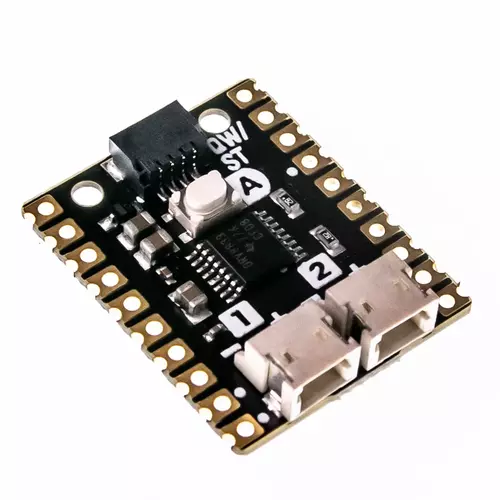Motor SHIM for Pico
Motor SHIM for Pico is backordered and will ship as soon as it is back in stock.
Couldn't load pickup availability

Call us on 1300 240 817 between 10 AM and 4 PM on weekdays or email team@littlebird.com.au .
The Fastest Shipping
The Fastest Shipping
We ship faster because we built our own shipping 🤖 robot.
Pi Australia is operated by Little Bird, and we go to great lengths to ship your orders, often within minutes.
You can view shipping options and pricing at checkout without logging in.
For orders over 500g (such as bulky items), shipping may cost more than the initial estimate.
We deliver across Australia, and here are the options (based on your location; view them on the cart page):
- Standard Post: Starting at $7 (6+ business days, with tracking)
- Express Post: Starting at $11 (2+ business days, with tracking)
- Same Day Delivery: Available for Sydney orders.
- Non-metro WA, NT, SA, and TAS: May take an additional 2+ days.

Solder this SHIM to the back of your Pico and unlock the magical ability to plug in up to two of our micro metal gearmotors (using these tidy short motor cables). To connect them up via cable, your motors will need to be equipped with Motor Connector Shims (but if you'd rather not solder the shims to the motors yourself, we also sell them with motors pre-attached).
In addition to the motor driver, Motor SHIM for Pico features a multi-purpose and ever popular user button plus a Qw/ST connector so you can attach breakouts and give your diminutive robot some smarts. You could use it to make a tiny front wheel drive robot (like a mini Trilobot) or even a matchbox sized balancing robot.
Motor SHIM for Pico is supported by a well documented C++/MicroPython motor library with lots of examples - there's even one to teach your motors how to sing! 🎶
- Dual H-Bridge motor driver (DRV8833)
- 2 JST-ZH connectors (2 pin) for attaching motors
- User button
- Qw/ST (Qwiic/STEMMA QT) connector for attaching breakouts
- Compatible with Raspberry Pi Pico.
- Soldering required.
- C++/MicroPython libraries
- Schematic
Raspberry Pi Pico, headers and other components shown are sold separately.
Assembly
You'll need to solder the SHIM to the back of your Pico, with the mounting holes lining up at the USB port end. The 'PICO MOTOR SHIM' text on the SHIM and the pin labels on the back of the Pico should be facing each other.
Software
Our C++/MicroPython libraries are packed with powerful features for working with motors. You'll get best performance using C++, but if you're a beginner we'd recommend using our batteries included MicroPython build for ease of getting started.
Alternatively, you can use CircuitPython to drive motors with your Raspberry Pi Pico, if you want access to all the nice conveniences of Adafruit's ecosystem.
Notes
- Dimensions: approx 26mm x 21mm x 5mm (L x W x H, including connectors)
- If you're ambitious in the ways of experimental soldering, you can try soldering the Pico and the SHIM both to the short end of your header, back to back - leaving the long ends of the pins free to plug into other things. This method makes for a much more slimline Pico/SHIM package, but you'll need to make sure your solder joints make good contact with the pads of both boards and the header.
- If you'd prefer not to attach Motor SHIM permanently to your Pico, consider soldering it to a pair of socket headers (as pictured in the photos of Pimoroni Pico LiPo).
- The little pink robot weighs just 68.8g! It uses Motor SHIM for Pico, LiPo SHIM for Pico, a 1/2" ball caster, white motor brackets , 32x7mm wheels and a dinky 150mAh LiPo battery. The chassis baseplate is laser cut from 3mm acrylic (download the .dxf file).
About Raspberry Pi Pico
Raspberry Pi Pico is a flexible, low cost microcontroller development board from the folks at Raspberry Pi, based on their very own chip - the RP2040. It's easily programmable over USB with C/C++ or MicroPython, and ideal for using in all sorts of physical computing projects, devices and inventions - we're so excited to see what you make with it!
We've called our Pico-sized add-ons packs, as they're designed to attach to the back of your Pico as if it were wearing a very stylish back pack (or a miniature jet pack, if you prefer). We've also got Pico bases (larger add-on boards with a space to mount your Pico on top) and some other boards that let you do interesting hackerly things like using multiple packs at once - click here to view them all!
Your Pico will need to have male headers soldered to it (with the pins pointing downwards) to attach to our add-on boards.
Payment & Security
Payment methods
Your payment information is processed securely. We do not store credit card details nor have access to your credit card information.




